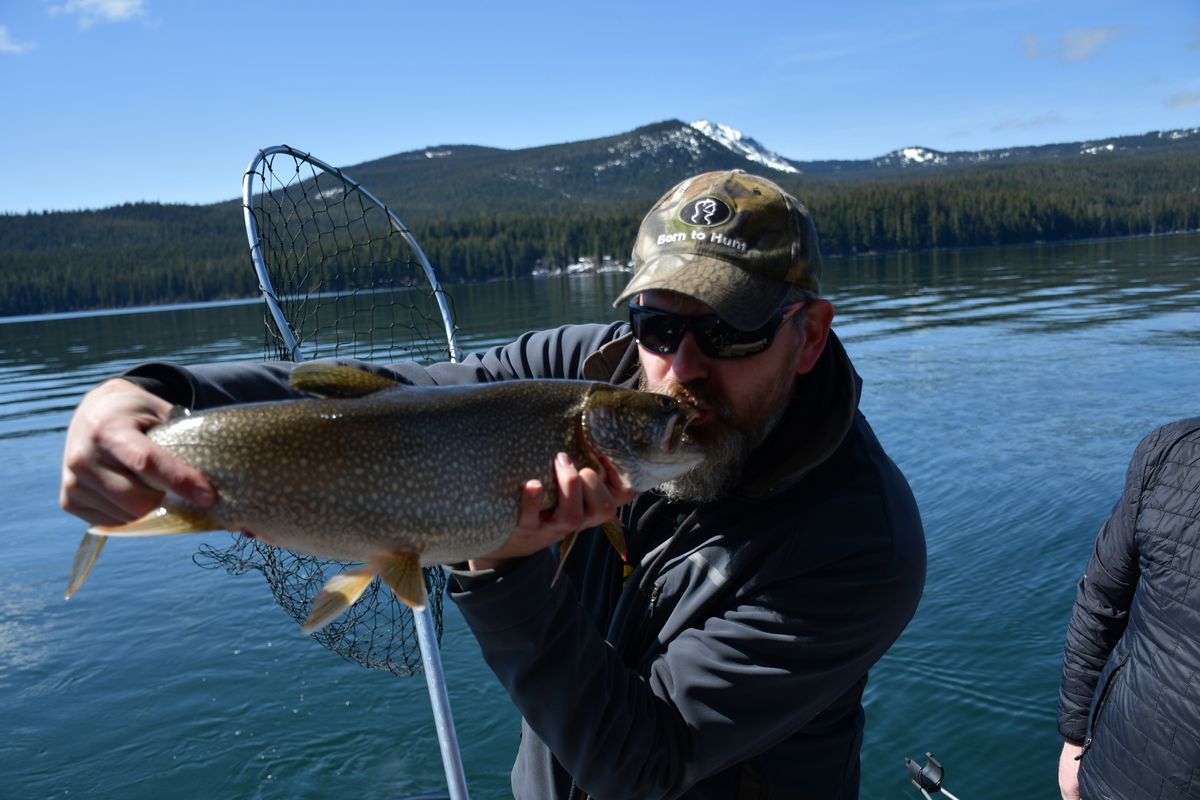Mackinaw trout can grow to monstrous proportions, but their bite – and their fight – can seem underwhelming

CRESCENT, Ore. – Steve Nicovich is trolling a large plug lure deep in the bowels of Odell Lake in search of one of its famed mottled marauders when something almost appears to happen.
Nicovich’s fishing line is attached to a downrigger 110 feet below, and his rod tip wiggles slightly, then it stops without enough force to trip the line off the downrigger clip.
Could that be a big mackinaw trout?
Nicovich grabs the rod and disengages the line from the downrigger.
As he starts to reel in the line, he discovers there might be a fish on the line. Five minutes later, a 10-pound mackinaw is in guide Davey Jones’ net, a technical knockout for a fight that never seemed to start.
“That was underwhelming,” Nicovich said. “I thought I was pulling the downrigger, then I was like, ‘Oh, it’s swimming to the left.’ Not a great fight, but it’s off my Bucket List.“
Catching a non-native mackinaw from a handful of Oregon waters like Odell Lake might not provide a fight of the month, let alone a tussle of a century, but catching one of inland Oregon’s largest piscatorial predators is something many anglers like Nicovich seek … at least once.
These Great Lakes natives were introduced decades ago to places like this Cascade crest lake on the Willamette Pass to create a unique angling opportunity for Western anglers steeped in salmon and steelhead.
While Oregon anglers might expect that the tug of a 15-pound mackinaw would rival the tussle of their native cousins here, they often are surprised at these carpetbagging char’s jet lag.
“They’re a beautiful fish,” said Jones, who guides mackinaw hunters on Odell out of a pontoon boat. “But sometimes the fight can be disappointing. Often, they don’t even fight until they come to the boat.”
These mackinaws technically aren’t a trout. They’re a char, a close cousin in another branch of the salmonid family.
They typically sport an olive-gray body with vanilla spots and big teeth that make rainbow trout look like pudding-slurpers.
The name mackinaw comes from a Midwest Indigenous tribe as well as an Island in Lake Michigan, where these char are prevalent. Other names include the truncated macs, as well as namaycush, lake char, touladi, togue and gray trout. In Lake Superior, it can also be variously known as siscowet, paperbelly and lean.
Their legend comes with their size.
Mackinaws up to 100 pounds have been documented in the Great Lakes, but Odell Lake owns the Oregon record of 40.5 pounds, caught in 1984.
If anything can knock Odell Lake off the mackinaw record podium, it’s nearby Crescent Lake. It’s already produced a 36-pounder and is open year-round, while Odell Lake remains under the old spring-through-Halloween regimen.
There’s also Cultus Lake in Central Oregon, where mackinaws up to 20 pounds have been caught. Like Odell Lake, northeast Oregon’s Wallowa Lake is almost 300 feet deep and has mackinaws.
So does Fourmile Lake between Medford and Klamath Falls. A relative newcomer to the mackinaw derby, it was first stocked in 1999.
But Odell Lake remains ground zero for mackinaw-stalkers.
The top ways to fish for them are two-fold, and they both sound like ways to fish Oregon’s ocean waters.
The most popular method is trolling large lures that look like cut-plug herring with downriggers, usually fishing the plugs about 100 feet away from the downrigger.
The other method is to use large jigs fished straight down off a boat as if anglers were searching for ocean rockfish. Jig away and wait for a light bite that belies these beasts’ predatory backstory.
In Odell Lake, they’re known as the apex predator of the deep. Most trout species such as rainbows feed primarily on insects, offering a diet that lends itself to relatively slow growth.
But Odell’s Mackinaws feed primarily on kokanee, or land-locked coho salmon. “Piscivorous” is the term for these types of critters whose palates prefer large plates of fish fillets over sipping individual insects less than 1,000th of their weight.
“They’re predators, and there is no bigger predator than the Mackinaw,” Jones says.
Not only have they out-competed the lake’s native bull trout for kokanee, Mackinaws have become so prolific at feeding on the lake’s bulging kokanee population that these fish can simultaneously grow collectively in population and individually in size.
“The population is really great right now,” Jones says. “Last year there were more Macs than ever. If anything, they’re overpopulated right now.
“At the same time, there are some old cabin-owners who say there are 50-pound fish here,” he says. “I believe it.”